MIS500: Latureae Business Model: Value Chain and Information Systems
VerifiedAdded on 2022/10/01
|10
|2207
|24
Report
AI Summary
This report provides a comprehensive analysis of Latureae, an Australian health and wellness company, focusing on its business model and value chain. It identifies both primary and secondary activities, along with their respective sub-activities, as defined by Michael Porter's value chain analysis. The report examines how these sub-activities contribute to value creation within Latureae's operations, encompassing areas such as inbound logistics, production, outbound logistics, marketing, sales, services, human resource management, technology development, and procurement. Furthermore, it establishes the links between these value-creating activities and sub-activities, providing a holistic view of the company's operations. Based on this analysis, the report offers several recommendations to Latureae, including enhancing customer relationship management through technology, leveraging social media marketing, improving infrastructure, and fostering stronger stakeholder collaborations to optimize its value chain and achieve its strategic objectives of market leadership, employee skill development, sustainable development, and competitive advantage.
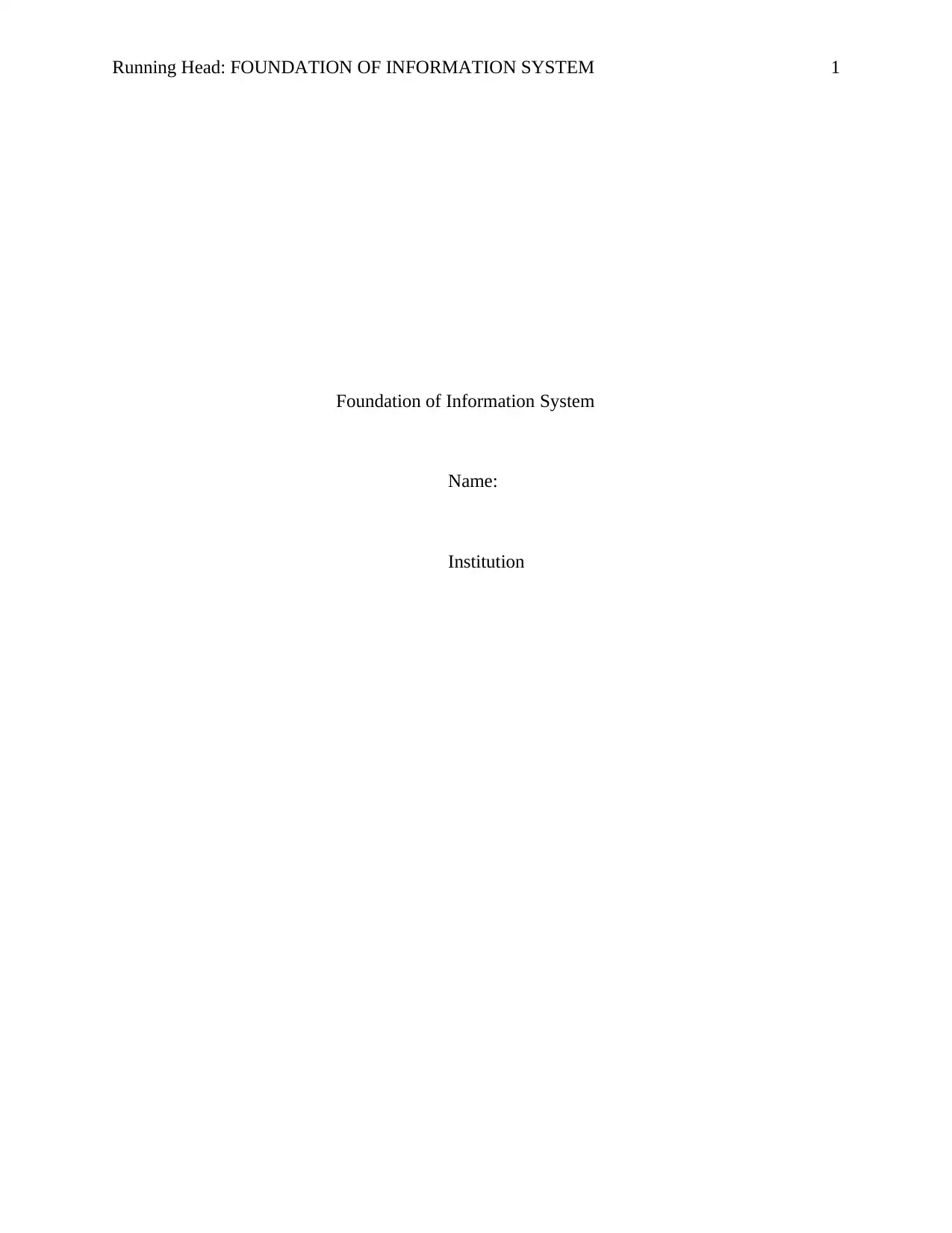
Running Head: FOUNDATION OF INFORMATION SYSTEM 1
Foundation of Information System
Name:
Institution
Foundation of Information System
Name:
Institution
Paraphrase This Document
Need a fresh take? Get an instant paraphrase of this document with our AI Paraphraser
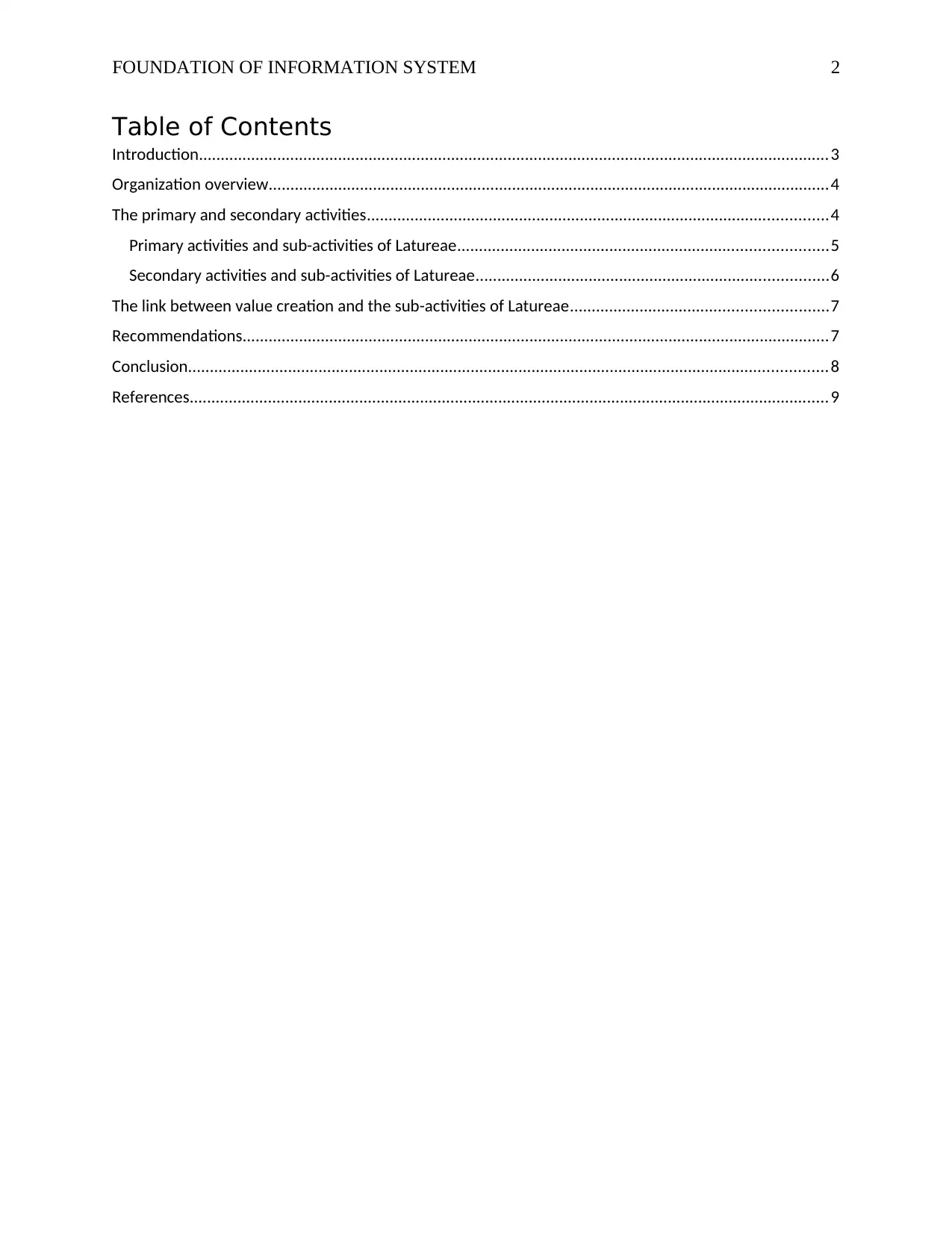
FOUNDATION OF INFORMATION SYSTEM 2
Table of Contents
Introduction.................................................................................................................................................3
Organization overview.................................................................................................................................4
The primary and secondary activities..........................................................................................................4
Primary activities and sub-activities of Latureae.....................................................................................5
Secondary activities and sub-activities of Latureae.................................................................................6
The link between value creation and the sub-activities of Latureae...........................................................7
Recommendations.......................................................................................................................................7
Conclusion...................................................................................................................................................8
References...................................................................................................................................................9
Table of Contents
Introduction.................................................................................................................................................3
Organization overview.................................................................................................................................4
The primary and secondary activities..........................................................................................................4
Primary activities and sub-activities of Latureae.....................................................................................5
Secondary activities and sub-activities of Latureae.................................................................................6
The link between value creation and the sub-activities of Latureae...........................................................7
Recommendations.......................................................................................................................................7
Conclusion...................................................................................................................................................8
References...................................................................................................................................................9
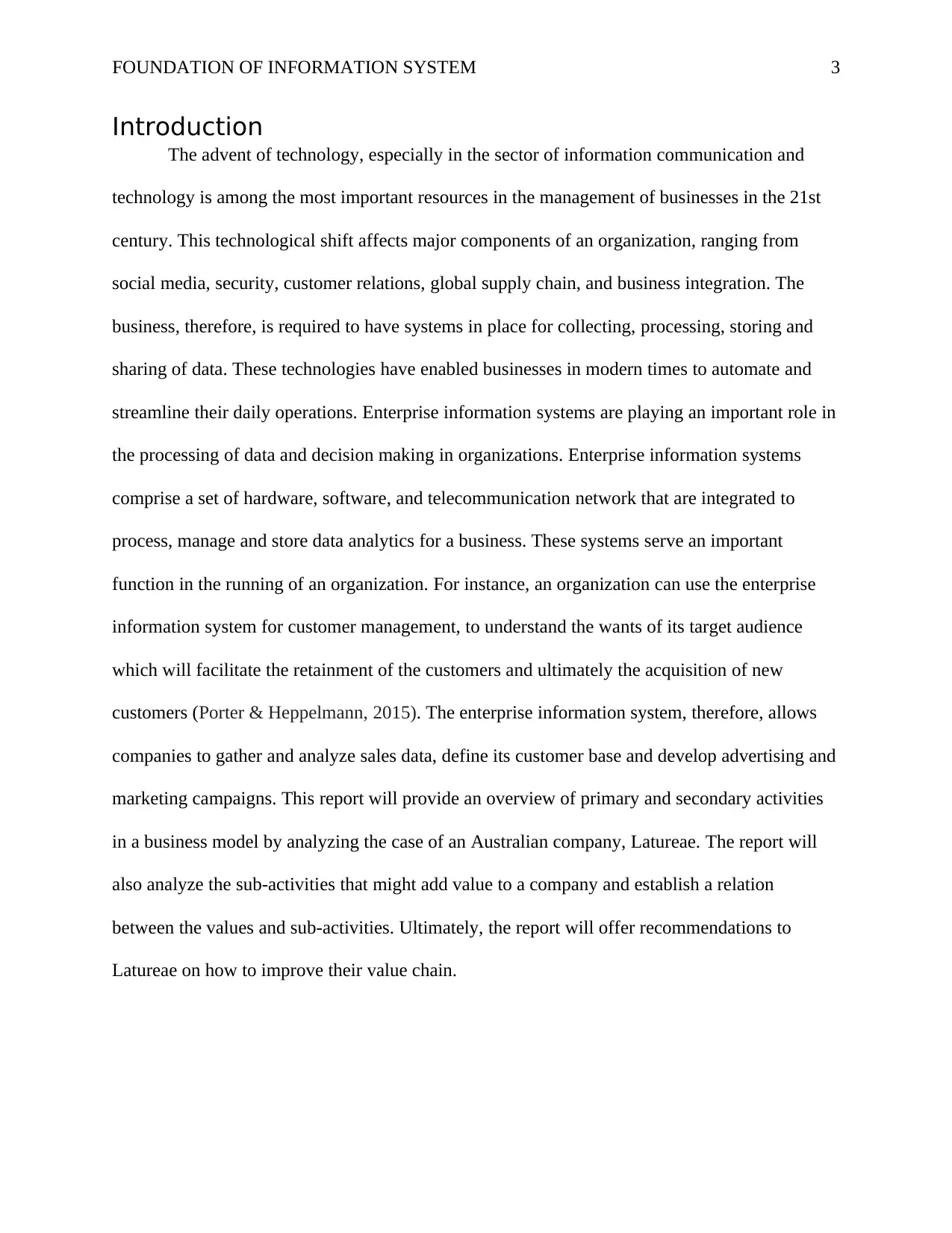
FOUNDATION OF INFORMATION SYSTEM 3
Introduction
The advent of technology, especially in the sector of information communication and
technology is among the most important resources in the management of businesses in the 21st
century. This technological shift affects major components of an organization, ranging from
social media, security, customer relations, global supply chain, and business integration. The
business, therefore, is required to have systems in place for collecting, processing, storing and
sharing of data. These technologies have enabled businesses in modern times to automate and
streamline their daily operations. Enterprise information systems are playing an important role in
the processing of data and decision making in organizations. Enterprise information systems
comprise a set of hardware, software, and telecommunication network that are integrated to
process, manage and store data analytics for a business. These systems serve an important
function in the running of an organization. For instance, an organization can use the enterprise
information system for customer management, to understand the wants of its target audience
which will facilitate the retainment of the customers and ultimately the acquisition of new
customers (Porter & Heppelmann, 2015). The enterprise information system, therefore, allows
companies to gather and analyze sales data, define its customer base and develop advertising and
marketing campaigns. This report will provide an overview of primary and secondary activities
in a business model by analyzing the case of an Australian company, Latureae. The report will
also analyze the sub-activities that might add value to a company and establish a relation
between the values and sub-activities. Ultimately, the report will offer recommendations to
Latureae on how to improve their value chain.
Introduction
The advent of technology, especially in the sector of information communication and
technology is among the most important resources in the management of businesses in the 21st
century. This technological shift affects major components of an organization, ranging from
social media, security, customer relations, global supply chain, and business integration. The
business, therefore, is required to have systems in place for collecting, processing, storing and
sharing of data. These technologies have enabled businesses in modern times to automate and
streamline their daily operations. Enterprise information systems are playing an important role in
the processing of data and decision making in organizations. Enterprise information systems
comprise a set of hardware, software, and telecommunication network that are integrated to
process, manage and store data analytics for a business. These systems serve an important
function in the running of an organization. For instance, an organization can use the enterprise
information system for customer management, to understand the wants of its target audience
which will facilitate the retainment of the customers and ultimately the acquisition of new
customers (Porter & Heppelmann, 2015). The enterprise information system, therefore, allows
companies to gather and analyze sales data, define its customer base and develop advertising and
marketing campaigns. This report will provide an overview of primary and secondary activities
in a business model by analyzing the case of an Australian company, Latureae. The report will
also analyze the sub-activities that might add value to a company and establish a relation
between the values and sub-activities. Ultimately, the report will offer recommendations to
Latureae on how to improve their value chain.
⊘ This is a preview!⊘
Do you want full access?
Subscribe today to unlock all pages.

Trusted by 1+ million students worldwide
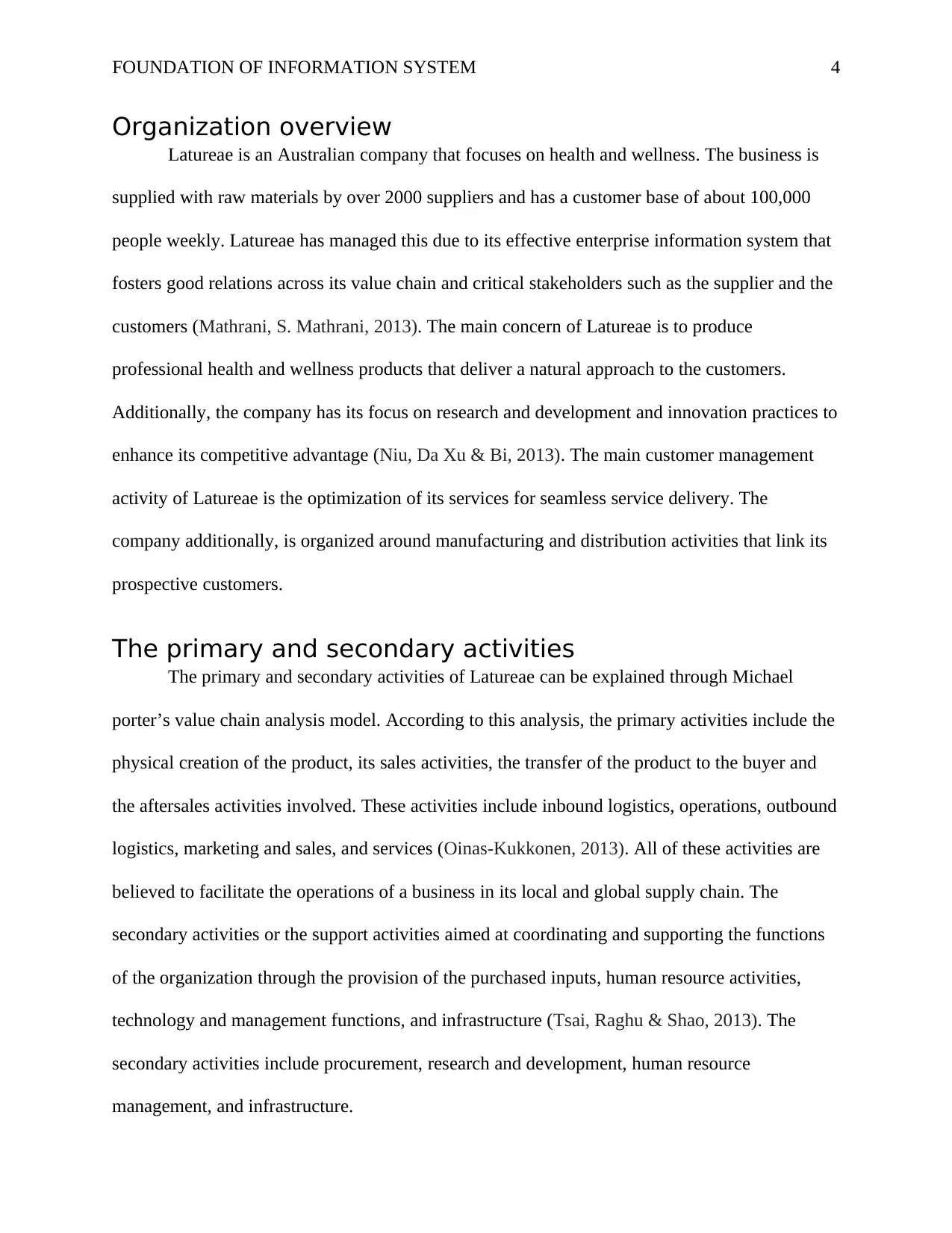
FOUNDATION OF INFORMATION SYSTEM 4
Organization overview
Latureae is an Australian company that focuses on health and wellness. The business is
supplied with raw materials by over 2000 suppliers and has a customer base of about 100,000
people weekly. Latureae has managed this due to its effective enterprise information system that
fosters good relations across its value chain and critical stakeholders such as the supplier and the
customers (Mathrani, S. Mathrani, 2013). The main concern of Latureae is to produce
professional health and wellness products that deliver a natural approach to the customers.
Additionally, the company has its focus on research and development and innovation practices to
enhance its competitive advantage (Niu, Da Xu & Bi, 2013). The main customer management
activity of Latureae is the optimization of its services for seamless service delivery. The
company additionally, is organized around manufacturing and distribution activities that link its
prospective customers.
The primary and secondary activities
The primary and secondary activities of Latureae can be explained through Michael
porter’s value chain analysis model. According to this analysis, the primary activities include the
physical creation of the product, its sales activities, the transfer of the product to the buyer and
the aftersales activities involved. These activities include inbound logistics, operations, outbound
logistics, marketing and sales, and services (Oinas-Kukkonen, 2013). All of these activities are
believed to facilitate the operations of a business in its local and global supply chain. The
secondary activities or the support activities aimed at coordinating and supporting the functions
of the organization through the provision of the purchased inputs, human resource activities,
technology and management functions, and infrastructure (Tsai, Raghu & Shao, 2013). The
secondary activities include procurement, research and development, human resource
management, and infrastructure.
Organization overview
Latureae is an Australian company that focuses on health and wellness. The business is
supplied with raw materials by over 2000 suppliers and has a customer base of about 100,000
people weekly. Latureae has managed this due to its effective enterprise information system that
fosters good relations across its value chain and critical stakeholders such as the supplier and the
customers (Mathrani, S. Mathrani, 2013). The main concern of Latureae is to produce
professional health and wellness products that deliver a natural approach to the customers.
Additionally, the company has its focus on research and development and innovation practices to
enhance its competitive advantage (Niu, Da Xu & Bi, 2013). The main customer management
activity of Latureae is the optimization of its services for seamless service delivery. The
company additionally, is organized around manufacturing and distribution activities that link its
prospective customers.
The primary and secondary activities
The primary and secondary activities of Latureae can be explained through Michael
porter’s value chain analysis model. According to this analysis, the primary activities include the
physical creation of the product, its sales activities, the transfer of the product to the buyer and
the aftersales activities involved. These activities include inbound logistics, operations, outbound
logistics, marketing and sales, and services (Oinas-Kukkonen, 2013). All of these activities are
believed to facilitate the operations of a business in its local and global supply chain. The
secondary activities or the support activities aimed at coordinating and supporting the functions
of the organization through the provision of the purchased inputs, human resource activities,
technology and management functions, and infrastructure (Tsai, Raghu & Shao, 2013). The
secondary activities include procurement, research and development, human resource
management, and infrastructure.
Paraphrase This Document
Need a fresh take? Get an instant paraphrase of this document with our AI Paraphraser
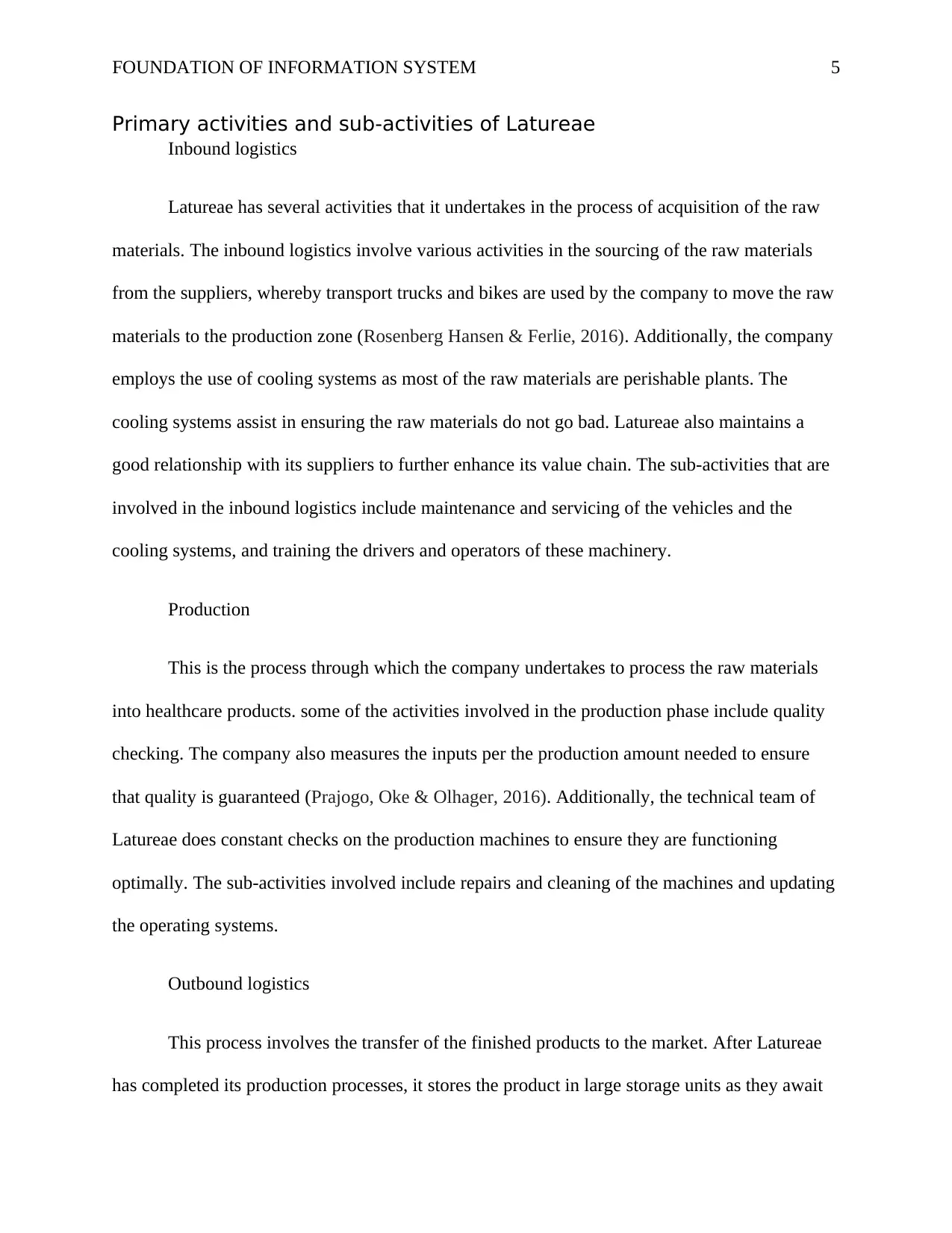
FOUNDATION OF INFORMATION SYSTEM 5
Primary activities and sub-activities of Latureae
Inbound logistics
Latureae has several activities that it undertakes in the process of acquisition of the raw
materials. The inbound logistics involve various activities in the sourcing of the raw materials
from the suppliers, whereby transport trucks and bikes are used by the company to move the raw
materials to the production zone (Rosenberg Hansen & Ferlie, 2016). Additionally, the company
employs the use of cooling systems as most of the raw materials are perishable plants. The
cooling systems assist in ensuring the raw materials do not go bad. Latureae also maintains a
good relationship with its suppliers to further enhance its value chain. The sub-activities that are
involved in the inbound logistics include maintenance and servicing of the vehicles and the
cooling systems, and training the drivers and operators of these machinery.
Production
This is the process through which the company undertakes to process the raw materials
into healthcare products. some of the activities involved in the production phase include quality
checking. The company also measures the inputs per the production amount needed to ensure
that quality is guaranteed (Prajogo, Oke & Olhager, 2016). Additionally, the technical team of
Latureae does constant checks on the production machines to ensure they are functioning
optimally. The sub-activities involved include repairs and cleaning of the machines and updating
the operating systems.
Outbound logistics
This process involves the transfer of the finished products to the market. After Latureae
has completed its production processes, it stores the product in large storage units as they await
Primary activities and sub-activities of Latureae
Inbound logistics
Latureae has several activities that it undertakes in the process of acquisition of the raw
materials. The inbound logistics involve various activities in the sourcing of the raw materials
from the suppliers, whereby transport trucks and bikes are used by the company to move the raw
materials to the production zone (Rosenberg Hansen & Ferlie, 2016). Additionally, the company
employs the use of cooling systems as most of the raw materials are perishable plants. The
cooling systems assist in ensuring the raw materials do not go bad. Latureae also maintains a
good relationship with its suppliers to further enhance its value chain. The sub-activities that are
involved in the inbound logistics include maintenance and servicing of the vehicles and the
cooling systems, and training the drivers and operators of these machinery.
Production
This is the process through which the company undertakes to process the raw materials
into healthcare products. some of the activities involved in the production phase include quality
checking. The company also measures the inputs per the production amount needed to ensure
that quality is guaranteed (Prajogo, Oke & Olhager, 2016). Additionally, the technical team of
Latureae does constant checks on the production machines to ensure they are functioning
optimally. The sub-activities involved include repairs and cleaning of the machines and updating
the operating systems.
Outbound logistics
This process involves the transfer of the finished products to the market. After Latureae
has completed its production processes, it stores the product in large storage units as they await
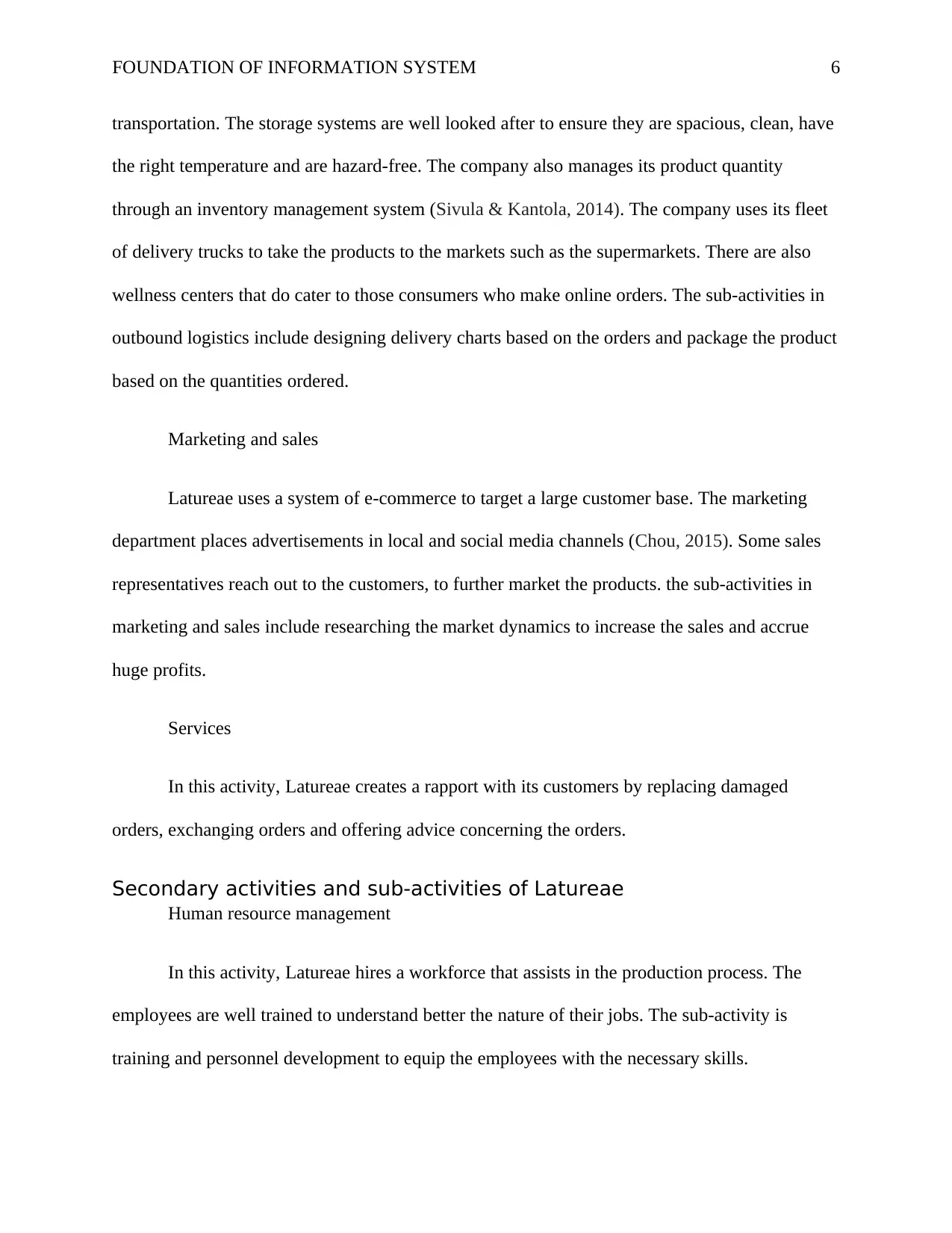
FOUNDATION OF INFORMATION SYSTEM 6
transportation. The storage systems are well looked after to ensure they are spacious, clean, have
the right temperature and are hazard-free. The company also manages its product quantity
through an inventory management system (Sivula & Kantola, 2014). The company uses its fleet
of delivery trucks to take the products to the markets such as the supermarkets. There are also
wellness centers that do cater to those consumers who make online orders. The sub-activities in
outbound logistics include designing delivery charts based on the orders and package the product
based on the quantities ordered.
Marketing and sales
Latureae uses a system of e-commerce to target a large customer base. The marketing
department places advertisements in local and social media channels (Chou, 2015). Some sales
representatives reach out to the customers, to further market the products. the sub-activities in
marketing and sales include researching the market dynamics to increase the sales and accrue
huge profits.
Services
In this activity, Latureae creates a rapport with its customers by replacing damaged
orders, exchanging orders and offering advice concerning the orders.
Secondary activities and sub-activities of Latureae
Human resource management
In this activity, Latureae hires a workforce that assists in the production process. The
employees are well trained to understand better the nature of their jobs. The sub-activity is
training and personnel development to equip the employees with the necessary skills.
transportation. The storage systems are well looked after to ensure they are spacious, clean, have
the right temperature and are hazard-free. The company also manages its product quantity
through an inventory management system (Sivula & Kantola, 2014). The company uses its fleet
of delivery trucks to take the products to the markets such as the supermarkets. There are also
wellness centers that do cater to those consumers who make online orders. The sub-activities in
outbound logistics include designing delivery charts based on the orders and package the product
based on the quantities ordered.
Marketing and sales
Latureae uses a system of e-commerce to target a large customer base. The marketing
department places advertisements in local and social media channels (Chou, 2015). Some sales
representatives reach out to the customers, to further market the products. the sub-activities in
marketing and sales include researching the market dynamics to increase the sales and accrue
huge profits.
Services
In this activity, Latureae creates a rapport with its customers by replacing damaged
orders, exchanging orders and offering advice concerning the orders.
Secondary activities and sub-activities of Latureae
Human resource management
In this activity, Latureae hires a workforce that assists in the production process. The
employees are well trained to understand better the nature of their jobs. The sub-activity is
training and personnel development to equip the employees with the necessary skills.
⊘ This is a preview!⊘
Do you want full access?
Subscribe today to unlock all pages.

Trusted by 1+ million students worldwide

FOUNDATION OF INFORMATION SYSTEM 7
Technology and development
The company is consistently working to develop innovations for cutting edge products.
these give the product the ability to tackle new and arising health issues. Additionally, the online
marketing campaign has enabled the company to acquire a new set of customers who are
increasingly placing orders on their digital platforms (Roblek, Pejić Bach, Meško & Bertoncelj,
2013). The sub-activities include the purchase and installation of modern information and
technology software.
Procurement
This involves the activity of purchasing means of production from different suppliers.
Latureae has overtime been sourcing for affordable and quality raw materials while emphasizing
on maintaining a good relationship with its suppliers (Bellamy & Basole, 2013). The sub-
activities involved in procurement are updating the inventories and delivery notices.
The link between value creation and the sub-activities of
Latureae
From the value chain model of Latureae, the sub-activities are important in supporting the
value creation. They ensure both the primary and secondary activities can be carried out
effectively and address any discrepancies that occur in the process (McPhee, 2014). The sub-
activities are focusing on increasing the value chain and competitive advantage of the
organization. Through the analysis of the value chain, Latureae needs to fix the existing
loopholes by increasing sales and reduce the cost of supply.
Technology and development
The company is consistently working to develop innovations for cutting edge products.
these give the product the ability to tackle new and arising health issues. Additionally, the online
marketing campaign has enabled the company to acquire a new set of customers who are
increasingly placing orders on their digital platforms (Roblek, Pejić Bach, Meško & Bertoncelj,
2013). The sub-activities include the purchase and installation of modern information and
technology software.
Procurement
This involves the activity of purchasing means of production from different suppliers.
Latureae has overtime been sourcing for affordable and quality raw materials while emphasizing
on maintaining a good relationship with its suppliers (Bellamy & Basole, 2013). The sub-
activities involved in procurement are updating the inventories and delivery notices.
The link between value creation and the sub-activities of
Latureae
From the value chain model of Latureae, the sub-activities are important in supporting the
value creation. They ensure both the primary and secondary activities can be carried out
effectively and address any discrepancies that occur in the process (McPhee, 2014). The sub-
activities are focusing on increasing the value chain and competitive advantage of the
organization. Through the analysis of the value chain, Latureae needs to fix the existing
loopholes by increasing sales and reduce the cost of supply.
Paraphrase This Document
Need a fresh take? Get an instant paraphrase of this document with our AI Paraphraser
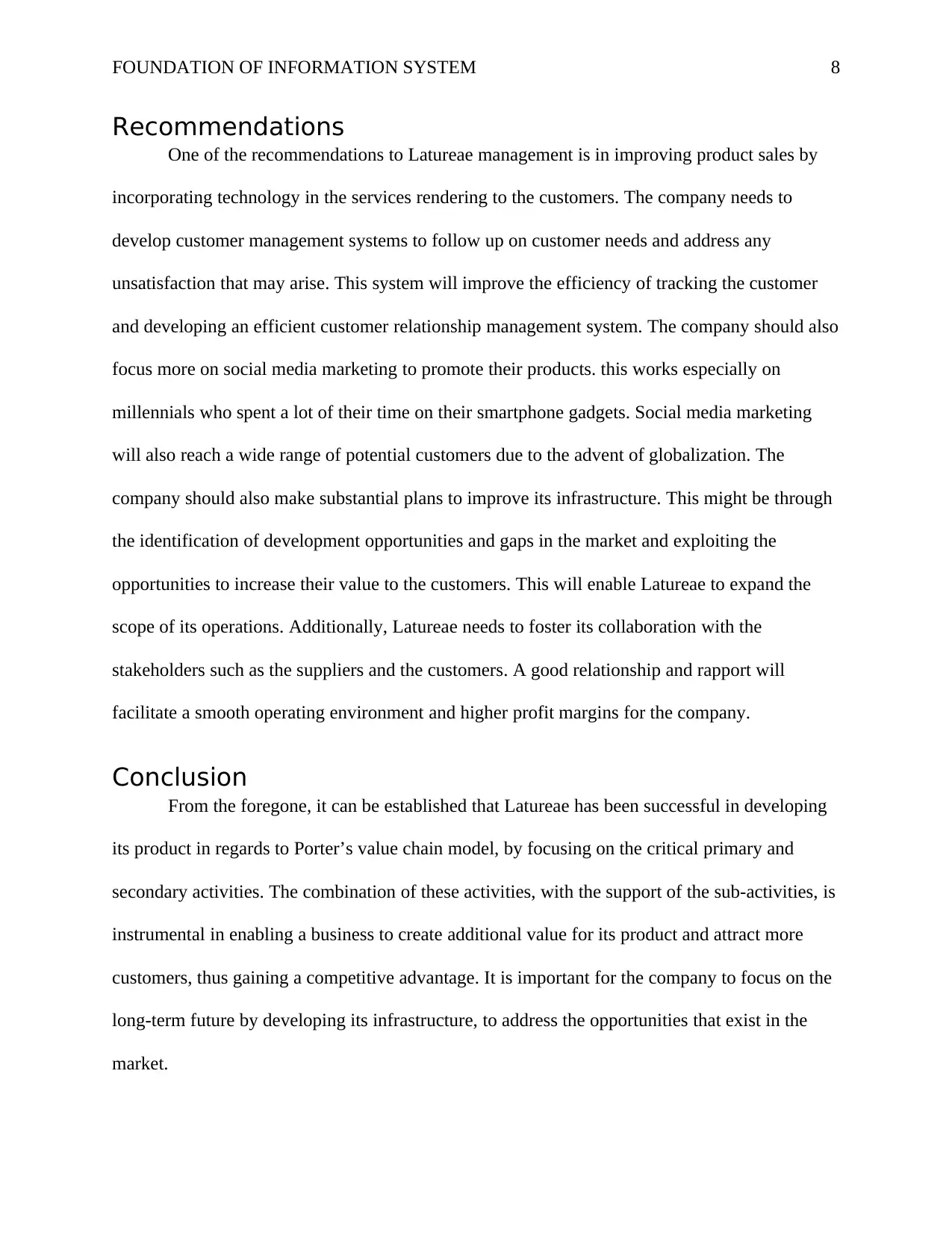
FOUNDATION OF INFORMATION SYSTEM 8
Recommendations
One of the recommendations to Latureae management is in improving product sales by
incorporating technology in the services rendering to the customers. The company needs to
develop customer management systems to follow up on customer needs and address any
unsatisfaction that may arise. This system will improve the efficiency of tracking the customer
and developing an efficient customer relationship management system. The company should also
focus more on social media marketing to promote their products. this works especially on
millennials who spent a lot of their time on their smartphone gadgets. Social media marketing
will also reach a wide range of potential customers due to the advent of globalization. The
company should also make substantial plans to improve its infrastructure. This might be through
the identification of development opportunities and gaps in the market and exploiting the
opportunities to increase their value to the customers. This will enable Latureae to expand the
scope of its operations. Additionally, Latureae needs to foster its collaboration with the
stakeholders such as the suppliers and the customers. A good relationship and rapport will
facilitate a smooth operating environment and higher profit margins for the company.
Conclusion
From the foregone, it can be established that Latureae has been successful in developing
its product in regards to Porter’s value chain model, by focusing on the critical primary and
secondary activities. The combination of these activities, with the support of the sub-activities, is
instrumental in enabling a business to create additional value for its product and attract more
customers, thus gaining a competitive advantage. It is important for the company to focus on the
long-term future by developing its infrastructure, to address the opportunities that exist in the
market.
Recommendations
One of the recommendations to Latureae management is in improving product sales by
incorporating technology in the services rendering to the customers. The company needs to
develop customer management systems to follow up on customer needs and address any
unsatisfaction that may arise. This system will improve the efficiency of tracking the customer
and developing an efficient customer relationship management system. The company should also
focus more on social media marketing to promote their products. this works especially on
millennials who spent a lot of their time on their smartphone gadgets. Social media marketing
will also reach a wide range of potential customers due to the advent of globalization. The
company should also make substantial plans to improve its infrastructure. This might be through
the identification of development opportunities and gaps in the market and exploiting the
opportunities to increase their value to the customers. This will enable Latureae to expand the
scope of its operations. Additionally, Latureae needs to foster its collaboration with the
stakeholders such as the suppliers and the customers. A good relationship and rapport will
facilitate a smooth operating environment and higher profit margins for the company.
Conclusion
From the foregone, it can be established that Latureae has been successful in developing
its product in regards to Porter’s value chain model, by focusing on the critical primary and
secondary activities. The combination of these activities, with the support of the sub-activities, is
instrumental in enabling a business to create additional value for its product and attract more
customers, thus gaining a competitive advantage. It is important for the company to focus on the
long-term future by developing its infrastructure, to address the opportunities that exist in the
market.

FOUNDATION OF INFORMATION SYSTEM 9
References
Bellamy, M. A., & Basole, R. C. (2013). Network analysis of supply chain systems: A
systematic review and future research. Systems Engineering, 16(2), 235-249.
Chou, D. C. (2015). Cloud computing: A value creation model. Computer Standards &
Interfaces, 38(6), 72-77.
Mathrani, S., & Mathrani, A. (2013). Utilizing enterprise systems for managing enterprise
risks. Computers in Industry, 64(4), 476-483.
McPhee, W. (2014). A new sustainability model: engaging the entire firm. Journal of Business
Strategy, 35(2), 4-12.
Niu, N., Da Xu, L., & Bi, Z. (2013). Enterprise information systems architecture—Analysis and
evaluation. IEEE Transactions on Industrial Informatics, 9(4), 2147-2154.
Oinas-Kukkonen, H. (2013). A foundation for the study of behavior change support
systems. Personal and ubiquitous computing, 17(6), 1223-1235.
Porter, M. E., & Heppelmann, J. E. (2015). How smart, connected products are transforming
companies. Harvard business review, 93(10), 96-114.
Prajogo, D., Oke, A., & Olhager, J. (2016). Supply chain processes: Linking supply logistics
integration, supply performance, lean processes and competitive
References
Bellamy, M. A., & Basole, R. C. (2013). Network analysis of supply chain systems: A
systematic review and future research. Systems Engineering, 16(2), 235-249.
Chou, D. C. (2015). Cloud computing: A value creation model. Computer Standards &
Interfaces, 38(6), 72-77.
Mathrani, S., & Mathrani, A. (2013). Utilizing enterprise systems for managing enterprise
risks. Computers in Industry, 64(4), 476-483.
McPhee, W. (2014). A new sustainability model: engaging the entire firm. Journal of Business
Strategy, 35(2), 4-12.
Niu, N., Da Xu, L., & Bi, Z. (2013). Enterprise information systems architecture—Analysis and
evaluation. IEEE Transactions on Industrial Informatics, 9(4), 2147-2154.
Oinas-Kukkonen, H. (2013). A foundation for the study of behavior change support
systems. Personal and ubiquitous computing, 17(6), 1223-1235.
Porter, M. E., & Heppelmann, J. E. (2015). How smart, connected products are transforming
companies. Harvard business review, 93(10), 96-114.
Prajogo, D., Oke, A., & Olhager, J. (2016). Supply chain processes: Linking supply logistics
integration, supply performance, lean processes and competitive
⊘ This is a preview!⊘
Do you want full access?
Subscribe today to unlock all pages.

Trusted by 1+ million students worldwide
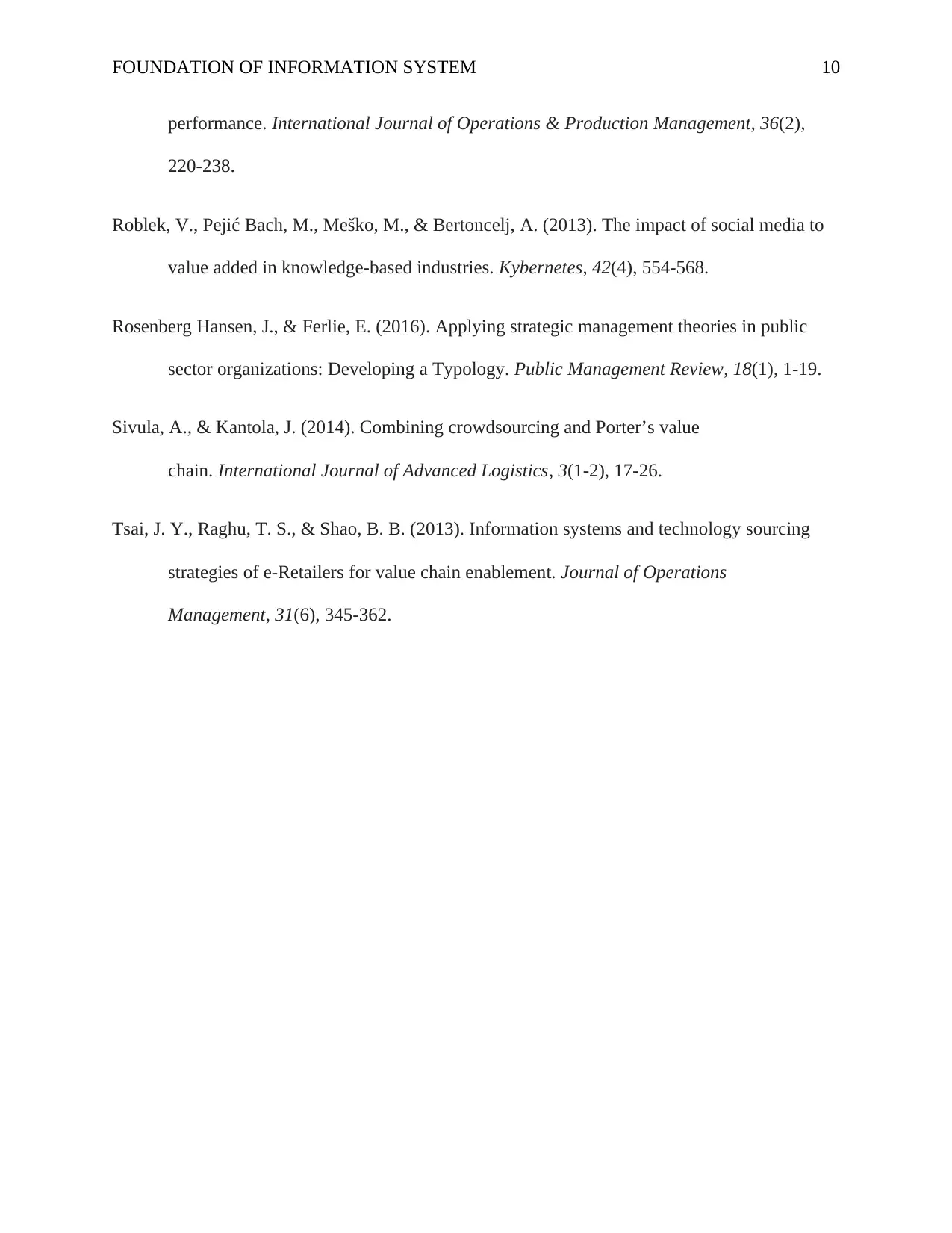
FOUNDATION OF INFORMATION SYSTEM 10
performance. International Journal of Operations & Production Management, 36(2),
220-238.
Roblek, V., Pejić Bach, M., Meško, M., & Bertoncelj, A. (2013). The impact of social media to
value added in knowledge-based industries. Kybernetes, 42(4), 554-568.
Rosenberg Hansen, J., & Ferlie, E. (2016). Applying strategic management theories in public
sector organizations: Developing a Typology. Public Management Review, 18(1), 1-19.
Sivula, A., & Kantola, J. (2014). Combining crowdsourcing and Porter’s value
chain. International Journal of Advanced Logistics, 3(1-2), 17-26.
Tsai, J. Y., Raghu, T. S., & Shao, B. B. (2013). Information systems and technology sourcing
strategies of e-Retailers for value chain enablement. Journal of Operations
Management, 31(6), 345-362.
performance. International Journal of Operations & Production Management, 36(2),
220-238.
Roblek, V., Pejić Bach, M., Meško, M., & Bertoncelj, A. (2013). The impact of social media to
value added in knowledge-based industries. Kybernetes, 42(4), 554-568.
Rosenberg Hansen, J., & Ferlie, E. (2016). Applying strategic management theories in public
sector organizations: Developing a Typology. Public Management Review, 18(1), 1-19.
Sivula, A., & Kantola, J. (2014). Combining crowdsourcing and Porter’s value
chain. International Journal of Advanced Logistics, 3(1-2), 17-26.
Tsai, J. Y., Raghu, T. S., & Shao, B. B. (2013). Information systems and technology sourcing
strategies of e-Retailers for value chain enablement. Journal of Operations
Management, 31(6), 345-362.
1 out of 10
Related Documents
Your All-in-One AI-Powered Toolkit for Academic Success.
+13062052269
info@desklib.com
Available 24*7 on WhatsApp / Email
![[object Object]](/_next/static/media/star-bottom.7253800d.svg)
Unlock your academic potential
Copyright © 2020–2025 A2Z Services. All Rights Reserved. Developed and managed by ZUCOL.





